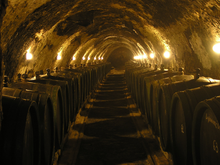Tokajská vinohradnícka oblasť
Tokaj is a wine-growing region in southeast Slovakia . According to the Slovakian view, it is 908 hectares or, as agreed with Hungary and recognized by the European Union , 565 hectares in size. The majority of the entire Tokaj- producing region lies in the Tokaj-Hegyalja wine-growing region , around 5860 hectares, on Hungarian territory. In 2002 the UNESCO declared Tokaj-Hegyalja as a cultural landscape a world cultural heritage . Slovakia is also preparing an application for inclusion of the Tokajská with UNESCO.
Dispute over demarcation
Only a small part of the traditional Tokaj area is now on Slovak territory. The old Tokaj wine region extended from Abaújszántó to Sátoraljaújhely ("New Town on the Tent Mountain ") and allegedly did not contain the three villages Kistoronya , Szőlőske and Kisújhely . The Hungarian noble family Andrássy , who had great influence in the Kingdom of Hungary , owned a piece of land in this area, which is why, according to the Hungarian daily newspaper Népszabadság , today's Slovak villages only came to the Tokaj region with the 1908 Wine Law. Through the Treaty of Trianon of 1920, the three villages, around 4% of the historic Tokaj wine region, became part of Czechoslovakia .
During the negotiations on EU accession in 2004, Hungary took the position that only the areas defined in the 1908 Wine Law were part of the historic Tokaj wine region. The area of the area assigned to Czechoslovakia in 1919/20, divided between the three villages, was originally 175 hectares. Slovakia, on the other hand, wanted to register an area of around 900 hectares and seven villages as part of the wine region. Hungary refused, but Agriculture Minister Imre Németh reached an agreement with his Slovak colleague on 565.5 hectares in order to be able to continue negotiations on EU accession. Both countries agreed that the Tokaj is a historical cultural heritage for both of them Countries are jointly responsible . As part of the contract, Slovakia had promised to apply the quality regulations applicable in Hungary, but this did not happen until 2009. In spring 2009, contrary to the agreement, Slovakia once again requested the extension of the appellation to 908 ha.
Products
The dessert wines as the most famous products of the wine-growing region comprise two types of wine. The first is the " Tokajer Samorod (n) er" ( Hungarian Szamorodni , a name that comes from Polish and means "as grown", in Slovak samorodné ). The wine is made from grapes that are only partially affected by noble mold , so that a selection is not worthwhile - hence the term "as grown". It is available in the flavors "dry" and "sweet". The second is the “Tokaj eruption” (ung. Aszú / asszú , sl. Výber / asu ). For this, every barrel (Göncer barrel of 136 l) of young wine is added 3 to 6 butter (ung. Puttony , sl. Putňa ) to 25 kg mash of separately selected berries infested with noble mold.
- three buns = at least 60 g / liter of residual sugar
- four buns = at least 90 g / liter of residual sugar
- five butter = at least 120 g / liter of residual sugar
- six butter = at least 150 g / liter of residual sugar
After fermentation and storage (at least 4-8 years, depending on the number of butter) in small wooden barrels in special, subterranean cellars, noble sweet wines with up to 18 percent alcohol by volume and a high proportion of sugar are produced, depending on the butter added as 3 to 6 buttery (ung. puttonyos , sl. putňový ) Aszú.
The most precious product is the Aszú-Esszencia. This is the juice that collects on the ground during storage of the berries infested with mold, approx. 140 ml per 25 kg and at least 450 g / liter of sugar, these figures vary depending on the weather.
Other types of wine are: Tokaj linden leafed (Hungarian Hárslevelű , sl. Lipovina ), Furmint and yellow muscatel (Hungarian Sárga-Muskotály , sl. Žltý Muškát ).
See also
Individual evidence
- ↑ http://ec.europa.eu/agriculture/markets/wine/e-bacchus/index.cfm?event=detailPEccgi&language=EN&eccgiId=5805
- ↑ Hugh Johnson , Steven Brook: The Great Johnson. The encyclopedia of wines. Wine-growing regions and wine producers in the world. Hallwag, Munich 2009, ISBN 978-3-8338-1621-5 , pp. 452ff.
- ^ Frieder Monzer: Slovakia. On the way between the Danube, Tatras and Beskids. Trescher Verlag, Berlin 2009, ISBN 978-3-89794-129-8 , p 298.
- ↑ a b Csak a csoda teheti tokajivá a szlovákok borát. In: Népszabadság. April 21, 2008, Retrieved February 22, 2010 (Hungarian).
- ↑ a b c Tőkeharc. In: Magyar Nemzet . April 19, 2008, accessed January 14, 2010 (Hungarian).
- ↑ a b The Tokaj War
- ↑ Tokaji: a szlovákok is teljesítsék a vállalásaikat. In: Népszabadság. December 18, 2009, accessed January 14, 2010 (Hungarian).
Web links
- Prager Zeitung online: Slovakia: Welcome to the Small Carpathian Wine Route (report from May 10, 2007)

